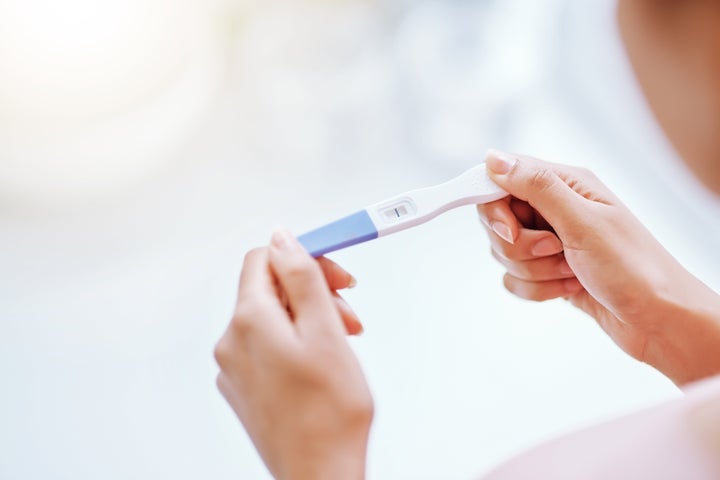
On a rainy November morning last year, a few days before Thanksgiving, I stuck my 11-month-old daughter in her car seat and took her with me to the obstetrician’s office. I had stopped breastfeeding her exactly six weeks before. I was pregnant again.
My appointment was with an obstetrician I’d never met before, at a practice affiliated with our city’s Catholic hospital. It was the largest practice in town, and the first appointment I could get.
“Last menstrual period?” the medical assistant asked as she wrapped a blood pressure cuff around my arm.
“I don’t know,” I said, blowing out a breath.
She glanced at me, then at my daughter, who was kicking and babbling in her car seat. “So,” she said, “This is unplanned.” I knew her tone; I had heard it a thousand times.
“I’m just here for an ultrasound,” I said, holding my voice steady. “I just want to know how far along I am.”
A recent trend in anti-abortion legislation has been the passing of so-called “heartbeat” bills, which ban an abortion after a “heartbeat” (the flicker of cardiac activity in an early embryo) can be detected on ultrasound. In 2019, such bills passed in six states ― including Georgia, Kentucky, Louisiana, Missouri, Mississippi and Ohio. Abortion rights advocates correctly point out that such legislation constitutes an outright abortion ban, because this early cardiac activity is detectable on a vaginal ultrasound at about six weeks, a time when most women do not even know they’re pregnant.
I often cringe when I hear this language — when most women don’t even know they’re pregnant — because I imagine how anti-abortion individuals, particularly men, must read it: as evidence that women are clueless and careless. (I can see a white-haired male politician scoffing, “How could a woman not know that she’s pregnant for a full six weeks?”)
But in reality, the technology used to detect a pregnancy — and the counterintuitive method of pregnancy dating — makes it almost impossible for any woman to know for sure that she’s pregnant before such cardiac activity appears. I know from experience — and not just my own.
What I didn’t tell the nurse that day was that I am a doctor. A large part of my job is detecting early pregnancies, determining whether the pregnancy is normal and viable, and counseling women about their options. (In my home state of California, thankfully, my patients have options to terminate the pregnancy, for any reason, up to about 24 weeks.) So if anyone could have known she was pregnant at the earliest possible moment, it should have been me.
After giving birth to my first child I’d made a conscious decision not to re-start birth control. I was 34 years old; I expected it might take several months or longer to conceive, but I was certain I wanted to be pregnant again. I breastfed my daughter until she was 10 months old, gradually introducing solid foods and formula until she was completely weaned. She was a good sleeper, and my husband and I were having sex again. I knew I could become pregnant at any moment — but I had no idea when that moment would be.
Like many women at various points in life (or throughout their lives), I wasn’t getting a regular period. I had never resumed my menses while breastfeeding (not uncommon, although not — as many believe — a reliable indicator of whether a woman has regained fertility). So I had no cue to watch for, no “missed” period to signal that I might be pregnant.
“A large part of my job is detecting early pregnancies, determining whether the pregnancy is normal and viable, and counseling women about their options... So if anyone could have known she was pregnant at the earliest possible moment, it should have been me.”
Sometime in early November, I just had a feeling. There were no classic symptoms: no sore breasts, no moodiness, no light spots of blood in my underwear. It was more like a premonition, a flutter in my chest, a suspicion.
Fortunately at my job, pregnancy tests are stacked on my desk like post-it notes. I took one home with me and peed on it: Positive. I was thrilled. The next afternoon on a walk with my husband, pushing our daughter in the stroller, we stepped into the lobby of a local hotel. I ordered two glasses of champagne at the bar and told him the news. He kissed me. “When?” He asked. I told him I didn’t know.
I needed an ultrasound. So the following week, back at work, I asked a nurse practitioner colleague to perform one for me between patients. It took her five minutes. But what we saw was concerning.
In a very early pregnancy, before enough cells have clustered together to form an embryo, there is only a tiny sac of fluid, called the “gestational sac,” which appears as a black oval inside the uterus. This sac appears just before five weeks. Just before six weeks, a white halo appears, called the yolk sac, which is the early nutritional source for the embryo. The embryo itself appears a day or two later. At six weeks — give or take a day or two — the earliest flicker of cardiac activity, what anti-abortion groups call the “heartbeat,” appears, confirming a viable, growing pregnancy.
The important thing to emphasize is that these weeks do not tally the amount of time the woman has been pregnant. They tally the number of weeks since her last period — if she was having a regular period at all. Ovulation, conception and implantation all take place at least two weeks after the menstrual period. Pregnancy hormone levels — the ones that produce that double blue line on a home pregnancy test — don’t become reliably detectable for another several days after that.
So, the “six weeks” at which the “heartbeat” appears is clinically standard but misleading language. The amount of time that has passed since a woman could possibly have known she was pregnant (if she could get her hands on a pregnancy test) is less than two weeks. Very few women can get into a doctor’s office for an ultrasound within two weeks of a home pregnancy test, let alone arrange for an abortion procedure.
But I was not seeking an abortion procedure. I just wanted to know something about this pregnancy — how long I had been pregnant and whether everything was okay.
That day in my clinic, because I didn’t know how far along I was, I didn’t know what I should expect to see on the ultrasound screen. What I saw was: nothing. Or, rather, only an empty gestational sac, with no yolk sac or embryo inside. I realized I was seeing either a very early pregnancy — i.e., about five weeks, before the emergence of an identifiable embryo. Or I was seeing something else, a pregnancy that had started growing and then stopped, something that would never grow into a fetus. This very common occurrence is sometimes called a “blighted ovum,” a “chemical pregnancy,” or, more correctly, an anembryonic gestation.
I tried not to panic. That night, I told my husband there was only one thing to do: wait.
A week later, I was at the ob-gyn’s office. I had decided if I was going to get bad news, I wanted it from a dispassionate professional, someone I didn’t know or work with.
The doctor breezed into the room and whisked out the vaginal ultrasound probe, coating it with a thick dollop of gel. He asked me again about my last period. I told him I hadn’t had one and had no idea how far along I was. He glanced at my daughter, now asleep in her car seat, her little chin tucked to her chest. “So, you weren’t planning on this, huh?” he said.
I disclosed to him that I was a doctor, and that I had done an ultrasound a week earlier, but hadn’t seen an embryo.
“Where do you practice?” he asked, “I haven’t heard your name in town.”
I named a clinic in a nearby city, well-known for its abortion care.
He raised an eyebrow.
“Look,” he said, “I understand you’ve got a very young kid already. I know how it is. You mean to plan these things, it’s harder than you think. The female body has a mind of its own. But you know I don’t do terminations here.”
I told him that I understood, said again that I wanted to be pregnant — “I just want to know if I really am or not.”
He seemed unconvinced, but he slid the probe between my legs. “Okay then, you know the drill: pressure, but not pain.”
An image appeared on the screen: My uterus; inside it, a black oval — the gestational sac — and at its center, a white blob, the embryo, with a tiny flicker inside of it.
“There you go,” he said.
A spreading warmth rose behind my eyes and nose. Something like a gasp caught in my throat.
With his digital calipers, he measured the embryo. “Six weeks and one day,” he said. He must’ve known I could see exactly what he did, but he said it anyway. “So, we’ve got a heartbeat. That’s a viable pregnancy. Is this what you wanted?”
“Yes!” I said.
I beamed at him, not caring about his patronizing tone, his stubborn insistence on judging me. The only possibility in that moment was that the whole world — including this smirking doctor who knew nothing about me, my family, my choices — shared in my relief and joy.
This was my experience as a family planning doctor: a pregnancy that I wanted and planned, but still didn’t see coming. It wasn’t a miracle that I detected the pregnancy this early: it was due to the pregnancy tests stacked on my desk at work, the colleague who could perform an ultrasound for me on request and — when I finally sought care through the usual channels — the fact that I was well-insured with relatively easy access to an obstetrician’s office, albeit one that offered limited services.
This was in a medically well-served suburban area of California. Imagine if I had been in rural Louisiana. Imagine if I hadn’t been a doctor. Imagine how any woman can possibly confirm a pregnancy and have a chance to decide whether she can or should continue it before, according to her state’s laws, it is too late.
The answer is simple: She can’t.
Christine Henneberg is a doctor and a writer.
Do you have a personal story you’d like to see published on HuffPost? Find out what we’re looking for here and send us a pitch!
